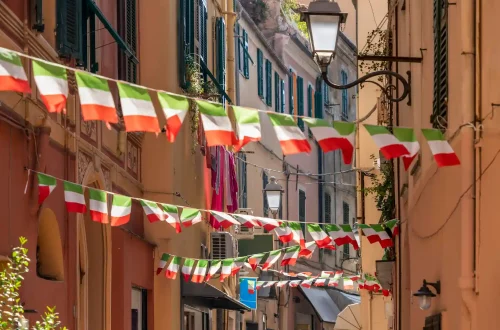Before the flourishing of the Renaissance, Italy was a fragmented mosaic of city-states, each with its own government, economy, and cultural identity.
The collapse of centralized imperial authority after the fall of the Western Roman Empire left the peninsula divided, paving the way for regional powers like Florence, Venice, Milan, and Naples to rise. These city-states often competed fiercely, not only in politics and warfare but also in art, architecture, and intellectual achievement.
The medieval period in Italy was marked by a complex interplay between the Church, feudal lords, and emerging urban elites.
While much of Europe remained rural and feudal, Italy saw the growth of vibrant urban centers, driven by trade, banking, and artisan production. This urbanization laid the groundwork for the cultural revival that would later define the Renaissance.
Economic and commercial factors
Italy’s geographic position made it a natural hub for trade between Europe, the Middle East, and North Africa. Cities like Venice and Genoa dominated maritime commerce, while Florence and Milan became centers of banking and textile production.
The rise of powerful merchant families—most notably the Medici in Florence—transformed the economic landscape and created a new class of wealthy patrons eager to invest in culture and innovation.
The accumulation of wealth in these urban centers enabled the funding of public works, religious buildings, and artistic commissions—many of which were sponsored by the Catholic Church.
Trade not only brought material prosperity but also facilitated the exchange of ideas, technologies, and artistic styles from across the Mediterranean world. This economic dynamism was a key driver of the intellectual and artistic energy that defined the Renaissance.
Take advantage of specialized assistance to secure your passport for a borderless future.
Patronage and elite sponsorship
During the Renaissance, Rome, the papacy, and the Papal States experienced significant transformation. The period was marked by extraordinary artistic and architectural achievements, with the Catholic Church actively commissioning and supporting renowned artists like Michelangelo, Raphael, Donatello, and others.
At the same time, powerful Italian families used their influence to obtain high-ranking positions within the Church, including the papacy, for their relatives (Lumen Learning, 2025).
Cultural and intellectual influences
During the Renaissance, Italy’s extensive trade networks across the Mediterranean played a key role in spreading cultural and intellectual ideas. The recovery of ancient Greek texts—preserved by Arab scholars and rediscovered after the Crusades—revived medieval philosophy and laid the foundation for renewed learning.
Following the Ottoman conquest of Byzantine territories, many Byzantine scholars relocated to Italy, contributing to the rise of linguistic studies in new academies in cities like Florence and Venice. Meanwhile, humanist thinkers explored monastic libraries to uncover forgotten Latin authors such as Tacitus.
The rediscovery of Vitruvius reintroduced classical architectural principles, inspiring Renaissance artists to surpass the achievements of ancient figures like Apelles in a spirit of humanist ambition (Lumen Learning, 2025).
Key figures and their contributions
Petrarch, often called the father of humanism, revived interest in classical texts and shaped the intellectual tone of the era. Artists like Giotto pioneered realistic representation in painting, while Brunelleschi revolutionized architecture with his use of linear perspective and engineering feats like the dome of Florence Cathedral.
Donatello’s sculptures brought emotional depth and classical form to religious subjects. These figures laid the foundation for later masters such as Leonardo da Vinci, Raphael, and Michelangelo.
Take advantage of specialized assistance to secure your passport for a borderless future.
Impact on art, science, and philosophy
The Renaissance transformed artistic expression through innovations in technique, perspective, and subject matter. Artists began to depict the human body with anatomical accuracy, explore secular themes, and experiment with light and shadow. Architecture embraced symmetry, proportion, and classical motifs, resulting in harmonious and enduring structures.
Scientific inquiry also flourished. Thinkers like Galileo Galilei and Leonardo da Vinci conducted experiments, made observations, and challenged traditional beliefs. The Renaissance marked a shift toward empirical reasoning and laid the groundwork for the Scientific Revolution.
Philosophically, the era emphasized individual dignity, civic responsibility, and the pursuit of knowledge. Thinkers such as Machiavelli explored political realism, while others debated ethics, metaphysics, and the role of reason in human affairs.
Legacy of the Italian Renaissance
The Italian Renaissance left a profound and lasting legacy. It reshaped European culture, education, and politics, influencing everything from art and literature to science and philosophy. Its ideals of humanism, creativity, and inquiry continue to inspire modern societies.
The movement also helped standardize the Italian language, elevate the status of artists and intellectuals, and redefine the relationship between the individual and the state. Today, the Renaissance is celebrated not only as a historical period but as a symbol of human potential and cultural achievement.
Whether through the frescoes of Florence, the manuscripts of Venice, or the sculptures of Rome, the Renaissance remains a testament to Italy’s enduring contribution to global civilization.
References
Lumen Learning. (n.d.). Italy during the Renaissance. World Civilizations I (HIS101) – Biel. Retrieved September 23, 2025, from https://courses.lumenlearning.com/suny-fmcc-boundless-worldhistory/chapter/italy-during-the-renaissance/






